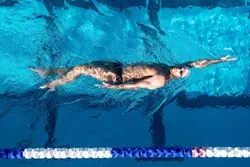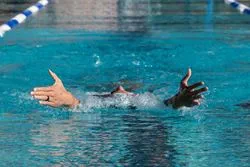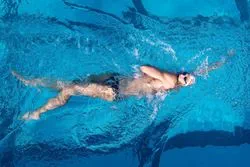Four Drills to Perfect Your Backstroke
Here are some of six-time Olympic medalist Matt Grevers’s favorite backstroke drills
Backstroke can be a difficult stroke to perfect.
You swim the stroke on your back, meaning you can’t see where you’re going, and swimming straight in an outdoor pool with no reference points above you can be especially difficult for even elite backstrokers who train outside all the time.
Maintaining good technique can be difficult. Common slip-ups include crossing over on your entry (your arm should enter in front of your shoulder, not behind your head), not getting a proper catch (push water toward your feet, not the side of the pool), and not rotating properly for more power and efficiency (drive your body rotation from your hips, taking your shoulders with it, so your body rotates about 30 to 45 degrees).
Six-time Olympic medalist Matt Grevers shares some of his favorite backstroke drills to help him maintain his elite-level performance. Try these drills and hone your technique, and you’ll be swimming like an Olympian.
1) Single-arm backstroke
 This is a tried-and-true drill that helps with body rotation and hand entry. As you can see to the left, every part of Grevers’s body except his head is rotated along his long axis once his hand enters the water. (Your hand should enter pinky-first to allow your hand to slide through the water and get you set up for your catch).
This is a tried-and-true drill that helps with body rotation and hand entry. As you can see to the left, every part of Grevers’s body except his head is rotated along his long axis once his hand enters the water. (Your hand should enter pinky-first to allow your hand to slide through the water and get you set up for your catch).
Once your hand enters and drops about a foot underwater, bend your elbow to set up your catch. Picture your catch as throwing water to your feet. The palm of your hand should face your feet as you perform your stroke. Once you’ve reached the end of your stroke, rotate to the other side, even though you’re not using that arm.
Rotating to both sides will allow you work on this important aspect of your stroke. Pay attention to how far you’re rotating to each side. If you’re rotating farther to one side, that gives you something to work on.
2) Double-arm Backstroke
Is this how you enter the water on backstroke? Double-arm backstroke will fix this problem.
This drill works nearly every aspect of backstroke except body rotation. If you find your hand enters behind your head, or if you have an imbalance in your stroke, this drill can correct those flaws and wake up your core muscles as a bonus.
As mentioned earlier, your hand should enter pinky-first. The perfect placement is at the “11” and “1” positions on a clock, not pointing directly behind you.
Grevers loves this drill because it forces him to find the correct entry position. If your hands are coming out of the water shoulder-width apart, great. If your hands touch, that’s bad—you’re overextending on your entry.
For your catch, unless you’re hyper-flexible, the only way to effectively do a backstroke pull in this drill is to bend your elbows about 90 degrees. You’ll feel your back muscles activating to create a good push.
3) Single- and Double-arm Backstroke
If your backstroke needs a serious overhaul, combining the single-arm and double-arm backstroke drills can help fix almost every flaw in your stroke. Perform two left-arm strokes and then two right-arm strokes to work on your body rotation and straight-arm recovery. Then throw in two double-arm strokes to help with the issues you experience with the hand placement on entry.
4) Single-arm Backstroke — With a Twist
 While spending time in Budapest, Hungary, for the International Swimming League in 2020, Grevers discovered a new drill that’s helped him understand the importance of core engagement. While doing the single-arm backstroke drill, he holds the lat muscle of the arm he’s using with his other arm.
While spending time in Budapest, Hungary, for the International Swimming League in 2020, Grevers discovered a new drill that’s helped him understand the importance of core engagement. While doing the single-arm backstroke drill, he holds the lat muscle of the arm he’s using with his other arm.
This drill “creates a core connection and a shoulder connection,” he says. “It has an automatic effect in terms of whole-body rotation. The tricky part is getting the hips involved. When your hips are turned and your core is engaged, all of your muscles are actually pulling you through the water instead of just your arm.”
Even an accomplished athlete such as Grevers needs to remind himself of the need to connect his core to his pull and kick. This drill will give you insight into how to use your entire body to create a more efficient and powerful stroke.
Categories:
- Technique and Training
SIGN UP FOR UPDATES FROM USMS















